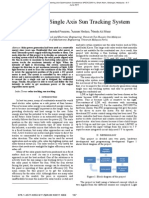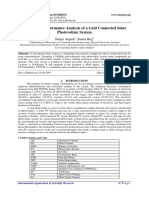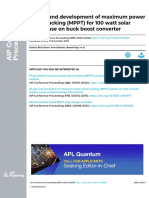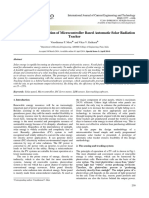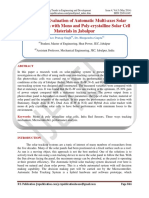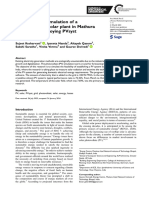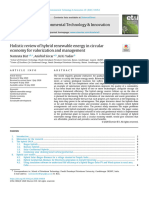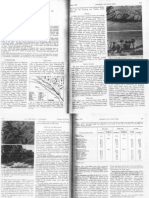Paper 1
Paper 1
Uploaded by
fathy syamCopyright:
Available Formats
Paper 1
Paper 1
Uploaded by
fathy syamOriginal Title
Copyright
Available Formats
Share this document
Did you find this document useful?
Is this content inappropriate?
Copyright:
Available Formats
Paper 1
Paper 1
Uploaded by
fathy syamCopyright:
Available Formats
INTERNATIONAL JOURNAL OF MECHANICS
DOI: 10.46300/9104.2020.14.21 Volume 14, 2020
Proposed Method for Two Axis Tracking of PV
Modules Using Advanced Microcontroller
Emad A. Sweelem, Mohamed I. Abu El-Sebah, Fathy A. Syam, Abouelmaaty M.Aly, Hanaa M.Farghally
Electronics Research Institute,
National Research Center Building, Dokki, Giza, 12622
Egypt
Received: June 3, 2020. Revised: September 14, 2020. Accepted: September 28, 2020. Published: September 30, 2020.
the same place almost invariant in a month and varies. little.
Abstract— In this study, a stand-alone photovoltaic
(latitude ± 10°) in a year. So, a single axis position. Control.
power system was designed and implemented to operate as
an application of a digital control system. Sun-tracker is scheme may be enough for the collection. of solar. Energy. in
implemented for improved efficiency of the system by
some applications. [4],[5]. So, the average of solar energy is
keeping the solar module perpendicular to the sun's
incoming rays. An experimental system was implemented not always maximized. Solar cell tracking system is essential
to demonstrate the effectiveness of the proposed system.
Experimental results are given to verify the system's for many applications such as thermal energy storage-systems
efficiency. A proposed method is employed to seek the and solar energy-based power-generation systems in order to
maximum power point using two lighting sensors the data
obtained from a two sensor is compared by get benefit to the system performance [6]. The variation in
microcontroller. Microcontroller is making PV module sun’s position is monitored, and the system. Always. Keeps.
track the maximum sun light which leads to obtain a
maximum power. The system is implemented using That. the plane of the panel. is normal. to the direction. of the
microcontroller and stepper motor and experimental work sun.,[6]. A little design. Methodologies. of PV tracking system
used to prove feasibility of the proposed method.
Keywords— Digital Control, Microcontroller, PV, Solar have been introduced in recent days [7],[8]. The dual axis
cell tracking. solar tracker uses an elevation actuator and an azimuth
I. INTRODUCTION actuator to alter the azimuth of an attached solar panel.
S. Shanmugam. et al. had. Given. the tracking. of the. Microcontroller. control the actuator. controller circuit. that
Sun. for solar paraboloidal. dish concentrators in [1]. Rong. - control the actuators. The Maximum. Power. point (MPP)
Jong. Wai et al. had. Given. Grid Connected photovoltaic (PV) tracking and output voltage. regulation (OVR) represent. the
generation. System. with an adaptive step-perturbation (ASP) two control. Modes. of a MIC [9]. Both control modes are
method and an active sun tracking scheme [2]. Cemil. Sungur. influenced. by the existence. of multiple. local maxima. and
Had. Given. the electromechanical. Control. System. of a PV one global MPP on the power–voltage characteristics of the
tracking the sun through the axis it moved along according to PV module [10],[11]. The existence of several local maxima is
its azimuth angle. [3]. The elevation. Angle. of the sun. be in attributed to the mismatch. between the submodules. due to
fabrication. tolerances, dust accumulation, or partial shading
[12], [13], [14]. In this context, the efficacy. of both controls.
ISSN: 1998-4448 157
INTERNATIONAL JOURNAL OF MECHANICS
DOI: 10.46300/9104.2020.14.21 Volume 14, 2020
modes rely. on various. factors. For the global MPP tracking.
Mode., on the one hand, the utilized. number of sensors,
speed. and accuracy. of tracking, ease. of implementation, and
cost are used. for quality assessment. [15], [16]. On the other
hand, tight dc bus voltage. control and balanced. power
sharing between. sources, also low converter power. Losses.
and the corresponding. Reduced. Heat. accumulation are the
indicators of the quality of the OVR mode [17].
Fig. 2: Block diagram circuit for dual-axis solar tracker.
In this paper, the MPP system is designed and successfully
implemented a digital controller system that is specifically
III. MPP TRACKING SYSTEM DESIGN
used in photovoltaic. This system makes the solar panel
tracking the light by using two photo sensors. The dual axis tracking technique is designed to track the sun
in both azimuth and altitude angles to enable the PV panel
II. MOTION OF THE SUN THROUGHOUT THE YEAR
perpendicular to the illumination of the sun:
A. Importance of Sun position
The PV panel used in this system amorphous silicon solar
Fig.1 shows the diagrammatic view where it shows the suns
cell, the maximum output power is 60W, open circuit voltage
motion in summer, winter & in spring. In a year sun takes
is 22V, short circuit current is 3.4A and its dimensions
different path in the sky. latitude only says the exact path of
315*925 mm and its weight 7.1 Kg (Fig. 3)
sun.
Fig. 3: Solar cell Module.
The mechanical mechanism as shown in Fig. 3 includes a
stepper motor and DC motor. The system consists of PV panel,
frame, stepper motor, DC motor, sensor circuit and driver
circuits.
Fig. 1: Diagrammatic view of motion of the sun throughout the year.
B. Dual-axis solar tracker A. Stepper Motor
A direct current (DC) motor runs by itself when voltage is
It (Fig. 2) shows the block. diagram of dual axis solar. tracker. supplied to it. In a DC motor, a split-ring commutator switches
Normally solar panel generate. solar power which is used for the direction of the current through the magnetic field coils
charging 12-volt battery. PIC microcontroller only gets power each half rotation to maintain the shaft’s direction of motion.
from the voltage regulator which is derived by battery. LCD. is A stepper motor can be viewed as an electric motor without a
attached with microcontroller and for exchanging. information commutator. All windings in the stepper motor are part of the
with a user a 4 ×4 matrix keypad is used. stator. The rotor is a permanent magnet or, in the case of
ISSN: 1998-4448 158
INTERNATIONAL JOURNAL OF MECHANICS
DOI: 10.46300/9104.2020.14.21 Volume 14, 2020
variable reluctance motors, a toothed block of some input pulses.
magnetically soft material. The motor controller handles all of
the commutation externally. Typically, the motor and IV. EXPERIMENTAL WORK
controller are designed so that the motor can be held in any A proposed method is employed to seek the
fixed position as well as rotated one way or the other. With the maximum power point using two lighting sensors the
appropriate controller, a stepper motor can start and stop “on a data obtained from a two sensor is compared by
dime” at controlled orientations. The repeatability of
microcontroller. Microcontroller is making PV
positioning with a stepper motor depends on the geometry of
module track the maximum sun light which leads to
the motor rotor. Some applications have the flexibility of using
obtain a maximum power. The system is
either stepper motors or servomotors. Although both types of
implemented using microcontroller and stepper motor
motors offer similar opportunities for precise positioning, they
differ in several ways. Servomotors require analog feedback and experimental work used to prove feasibility of the
control systems. Typically, this involves a potentiometer to proposed method.
provide feedback about the rotor position and circuitry to drive
A. Interfacing Circuit.
a current through the motor. The current is inversely
Fig. 4 shows the power supply implemented to feed
proportional to the difference between the desired position and
each element in the whole circuit which ensure the supply to
the current position. Stepper motors can be used in simple
the circuit and the stepper motor. Interfacing circuit has been
open-loop control systems. They are generally adequate for
implemented to subject the PV module to the light ensuring the
systems that operate at low accelerations with static loads.
maximum power generated. The two light sensors which used
to detect the light direction are connected as shown in Fig. 5.
a. Stepper Motor Advantages
Stepper motor interfacing circuit is shown in Fig.6 which uses
1. The rotation angle of the motor is proportional to the input
ULN 2003 as a driver to the stepper motor. The stepper motor
pulse.
control the movement of the PV system towards the light.
2. The motor has full torque at standstill (if the windings are
energized)
3. Precise positioning and repeatability of movement since
good stepper motors have an accuracy of 3 – 5% of a step and
this error is non-cumulative from one step to the next.
4. Excellent response to starting/ stopping/reversing.
5. Very reliable since there are no contact brushes in the
motor. Therefore, the life of the motor is simply dependent on
the life of the bearing.
6. The motors response to digital input pulses provides open-
Fig. 4: The power supply schematic diagram
loop control, making the motor simpler and less costly to
control.
7. It is possible to achieve very low speed synchronous
rotation with a load that is directly coupled to the shaft.
8. A wide range of rotational speeds can be realized as
the speed is proportional to the frequency of the
ISSN: 1998-4448 159
INTERNATIONAL JOURNAL OF MECHANICS
DOI: 10.46300/9104.2020.14.21 Volume 14, 2020
C. System Implementation
Figures 9,10 show the implemented system hardware. Fig.
8 shows the microcontroller Board used to control the tracker
system, while the whole system is illustrated in Fig.9
Fig. 5: The lighting sensor schematic diagram.
Fig. 8: the microcontroller Board.
Fig. 6: Schematic diagram of the stepper motor drive circuit
B. Software Program
Flowchart of the software program is illustrated in the Fig. 7,
which shows also the detailed flowchart. This flowchart is
converted to assembly.
LE
Fig. 9: the tracking control system.
V. RESULTS
The power resulting against time characteristic (C/C) is
shown in Fig.10, indicate that there is an overall increase of
output energy about 25% for the two-axis MPP tracking
system compared to the fixed PV system as shown in Fig.11.
The tracking mechanism can track the sun according to the
direction of beam propagation of solar radiation and it has a
provision. in the software for adjustment of the system in case
Fig. 7: The Control program flowchart
of seasonal variation if necessary. The power. Consumption.
by the system is very low because of low energy consumption
devices are used like as COMS digital IC’s and other low
ISSN: 1998-4448 160
INTERNATIONAL JOURNAL OF MECHANICS
DOI: 10.46300/9104.2020.14.21 Volume 14, 2020
power consuming solid-state electronic components. Also, [2] G. AlLee and W. Tschudi, “Edison redux: 380 Vdc brings
reliability and efficiency to sustainable data centers,” IEEE
consumes. a small amount of energy. as it rotates only for a
Power Energy Mag., vol. 10, no. 6, pp. 50–59, Nov.–Dec.
fraction of every interval of time. 2012.
[3] E. Romero-Cadaval, G. Spagnuolo, L. G. Franquelo, C.-
Andr´es Ramos-Paja, T. Suntio, andW.-Michael Xiao, “Grid-
connected photovoltaic generation plants: Components and
operation,” IEEE Ind. Electron. Mag., vol. 7, no. 3, pp. 6–20,
Sep. 2013.
[4] L. Eggenschwiler,M. Adly, P. Favre-Perrod, and K. Strunz,
“Closed-loop impedance calculation of grid-tied three-phase
inverters/rectifiers in bus signaling strategy-controlled DC
microgrids,” in Proc. IEEE 2nd Int. Conf. DC Microgrids,
Jun. 2017, pp. 309–315.
[5] R. C. N. Pilawa-Podgurski and D. J. Perreault, “Submodule
integrated distributed maximum power point tracking for solar
photovoltaic applications,” IEEE Trans. Power Electron., vol.
28, no. 6, pp. 2957–2967, Jun. 2013.
Fig. 10: Power-Time variation of Normal and MPPT.
[6] M. Adly and K. Strunz, “Irradiance-adaptive PV module
integrated converter for high efficiency and power quality in
standalone and DC microgrid applications,” IEEE Trans. Ind.
Electron., vol. 65, no. 1, pp. 436–446, Jan. 2018.
[7] S. Sajadian and R. Ahmadi, “Distributed maximum power
point tracking using model predictive control for photovoltaic
energy harvesting architectures based on cascaded power
optimizers,” IEEE J. Photovolt., vol. 7, no. 3, pp. 849–857,
May 2017.
[8] A. M. S. S. Andrade, L. Schuch, and M. L. da Silva
Martins, “High step up PV module integrated converter for PV
energy harvest in FREEDM systems,” IEEE Trans. Ind. Appl.,
Fig. 11: Energy production comparing for normal and
vol. 53, no. 2, pp. 1138–1148, Mar. 2017.
MPPT system.
[9] N. L. Diaz, T. Dragicevic, J. C. Vasquez, and J. M.
Guerrero, “Intelligent distributed generation and storage units
for DC microgrids—A new concept on cooperative control
VI. CONCLUSION without communications beyond
In this paper, tracker for solar PV module system has been droop control,” IEEE Trans. Smart Grid, vol. 5, no. 5, pp.
2476–2485, Sep. 2014.
Designed and implemented with microcontroller using two [10] H. Patel and V.Agarwal,“MATLAB-basedmodeling to
light sensors and stepper motor controlling the module study the effects of partial shading on PVarray characteristics,”
IEEE Trans. Energy Convers., vol. 23, no. 1, pp. 302–310,
polarization. The system is controlled by 89c52 Mar. 2008.
microcontroller to produce maximum available power that the [11] A. Ramyar,H. Iman-Eini, and S. Farhangi, “Global
maximum power point tracking method for photovoltaic arrays
PV array can generate under all operating conditions. The under partial shading conditions,” IEEE Trans. Ind. Electron.,
software and hardware have been tested and verified the vol. 64, no. 4, pp. 2855–2864, Apr. 2017.
[12] C. Olalla, C. Deline, and D. Maksimovic, “Performance
required aim of design. of mismatched PV systems with submodule integrated
converters,” IEEE J. Photovolt., vol. 4, no. 1, pp. 396–404,
The proposed method offers advantages of simplified Jan. 2014.
hardware configuration, low cost and fast convergence to [13] J. Ahmed and Z. Salam, “An improved method to predict
the position of maximum power point during partial shading
reach the Maximum power. for PV arrays,” IEEE Trans. Ind. Inform., vol. 11, no. 6, pp.
1378–1387, Dec. 2015.
[14] B. N. Alajmi, K. H. Ahmed, S. J. Finney,
References andB.W.Williams, “A maximum power point tracking
[1] K. St., E. Abb., and D. N. Huu., “DC microgrid for wind technique for partially shaded photovoltaic systems in
and solar power integration,” IEEE J. Emerg. Sel. Topics microgrids,” IEEE Trans. Ind. Electron., vol. 60, no. 4, pp.
Power Electron., vol. 2, no. 1, pp. 115–126, Mar. 2014. 1596–1606, Apr. 2013.
ISSN: 1998-4448 161
INTERNATIONAL JOURNAL OF MECHANICS
DOI: 10.46300/9104.2020.14.21 Volume 14, 2020
[15] H. Patel and V. Agarwal, “Maximum power point Creative Commons Attribution License 4.0
tracking scheme for PV systems operating under partially (Attribution 4.0 International, CC BY 4.0)
shaded conditions,” IEEE Trans. Ind. Electron., vol. 55, no. 4,
pp. 1689–1698, Apr. 2008. This article is published under the terms of the Creative
[16] T. L. Nguyen and K. S. Low, “A global maximum power Commons Attribution License 4.0
point tracking scheme employing DIRECT search algorithm https://creativecommons.org/licenses/by/4.0/deed.en_US
for photovoltaic systems,” IEEE Trans. Ind. Electron., vol. 57,
no. 10, pp. 3456–3467,
Oct. 2010.
[17] Y. Jiang, J. A. Abu Qahouq, and T. A. Haskew,
“Adaptive step size with adaptive-perturbation-frequency
digital MPPT controller for a single sensor photovoltaic solar
system,” IEEE Trans. Power Electron., vol. 28, no. 7, pp.
3195–3205, Jul. 2013.
ISSN: 1998-4448 162
You might also like
- Dark Void (Official Prima Guide)Document161 pagesDark Void (Official Prima Guide)mikel4carbajoNo ratings yet
- Mill Testing Optimisation and TargetingDocument134 pagesMill Testing Optimisation and TargetingArtemMirra90% (10)
- Manu PDFDocument4 pagesManu PDFVipin palNo ratings yet
- Photovoltaic Power Optimization Using Sliding Mode Control With A Two-Axis Tracking SystemDocument6 pagesPhotovoltaic Power Optimization Using Sliding Mode Control With A Two-Axis Tracking Systemtu170No ratings yet
- Sharma 2017 Solar TrackingDocument6 pagesSharma 2017 Solar TrackingsashaNo ratings yet
- Low-Cost Dual-Axis System For Solar Tracking: Dimitrija Angelkov Natasa Koceska Saso KoceskiDocument4 pagesLow-Cost Dual-Axis System For Solar Tracking: Dimitrija Angelkov Natasa Koceska Saso KoceskiRegard AlestairNo ratings yet
- A Solar Panel Tracking System Repair Using Additional Mass Position Adjustment 10Document10 pagesA Solar Panel Tracking System Repair Using Additional Mass Position Adjustment 10Ir Solly Aryza MengNo ratings yet
- Sun Tracker Full ReportDocument23 pagesSun Tracker Full ReportGiridhar SinghNo ratings yet
- Model Predictive Control of 2-Axis Solar Tracker For Solar Energy SystemDocument6 pagesModel Predictive Control of 2-Axis Solar Tracker For Solar Energy SystemRegard AlestairNo ratings yet
- EEC Microproject.Document19 pagesEEC Microproject.Pranay DholeNo ratings yet
- Visvesvaraya Technological University: Solar Panel With Sun Tracking Using IotDocument26 pagesVisvesvaraya Technological University: Solar Panel With Sun Tracking Using Iotajjappa tNo ratings yet
- 6342-Article Text-18708-1-10-20240125Document16 pages6342-Article Text-18708-1-10-20240125Abusabah I. A. AhmedNo ratings yet
- Survey On Automatic Solar Tracking SystemDocument3 pagesSurvey On Automatic Solar Tracking SystemInternational Journal of Innovations in Engineering and ScienceNo ratings yet
- Simulation Regarding Solar Panel Tracking System BDocument7 pagesSimulation Regarding Solar Panel Tracking System Bahmedravat28No ratings yet
- Helianthus: The Solar Tracking SystemDocument17 pagesHelianthus: The Solar Tracking SystemSampath KumarNo ratings yet
- Rushi Bhaiya ProjectDocument29 pagesRushi Bhaiya ProjectRushikesh MundeNo ratings yet
- Solar Sunlight TrackerDocument38 pagesSolar Sunlight Trackersukumarloganathan2003No ratings yet
- Solartrackingsystem 160325184948Document26 pagesSolartrackingsystem 160325184948lubna dheisatNo ratings yet
- Solar TrackingDocument5 pagesSolar TrackingpranjaliNo ratings yet
- Solar Tracking SystemsDocument25 pagesSolar Tracking SystemsUncle TravelsNo ratings yet
- Analysis of An Arduino Based Solar Tracking SystemDocument8 pagesAnalysis of An Arduino Based Solar Tracking SystemkyawtNo ratings yet
- A Sun Tracking System Design For A Large Dish SolaDocument5 pagesA Sun Tracking System Design For A Large Dish SolaGOURANSH BHATNAGARNo ratings yet
- Dual Axis Solar Tracking System With Weather SensorDocument6 pagesDual Axis Solar Tracking System With Weather SensorIJRASETPublicationsNo ratings yet
- 11 - 21 - A Microcontroller-Based Multi-Function Solar Tracking System.Document4 pages11 - 21 - A Microcontroller-Based Multi-Function Solar Tracking System.Chawki ChouraNo ratings yet
- Solar TrackerDocument4 pagesSolar TrackerJournalNX - a Multidisciplinary Peer Reviewed Journal100% (1)
- Dual Axis Solar Tracking SystemDocument13 pagesDual Axis Solar Tracking SystemZaid MapariNo ratings yet
- Paper PDFDocument7 pagesPaper PDFAravindNo ratings yet
- IJETR022984Document3 pagesIJETR022984erpublicationNo ratings yet
- 16.automatic Dual-Axis Solar Tracking System PDFDocument5 pages16.automatic Dual-Axis Solar Tracking System PDFnadeemq_0786No ratings yet
- Development of Solar Tracking System Using Imc-Pid ControllerDocument8 pagesDevelopment of Solar Tracking System Using Imc-Pid ControllerAJER JOURNALNo ratings yet
- Design and Implementation of An Off-Grid Solar Tracker Control System Using Proteus 8.1Document9 pagesDesign and Implementation of An Off-Grid Solar Tracker Control System Using Proteus 8.1Hachimenum AmadiNo ratings yet
- An Automated Intelligent Solar Tracking Control System With Adaptive Algorithm For Different Weather ConditionsDocument5 pagesAn Automated Intelligent Solar Tracking Control System With Adaptive Algorithm For Different Weather ConditionsThagasheriff MohamedmustaqahmedNo ratings yet
- Othman 2013Document6 pagesOthman 2013Dilekh AnisNo ratings yet
- A Design of Single Axis Sun Tracking SystemDocument4 pagesA Design of Single Axis Sun Tracking SystemMazhar UddeenNo ratings yet
- (REPORT) - Automatic Sun Tracking SystemDocument14 pages(REPORT) - Automatic Sun Tracking SystemPrashant Kumar100% (1)
- Design and Performance Analysis of A GriDocument5 pagesDesign and Performance Analysis of A GriSidiabdoulah dahNo ratings yet
- An Efficient Solar Energy Harvesting System For Wireless Sensor Nodes 2018Document4 pagesAn Efficient Solar Energy Harvesting System For Wireless Sensor Nodes 2018Gopal DandimeNo ratings yet
- Solar Power Monitoring Using IoT (Report Book)Document41 pagesSolar Power Monitoring Using IoT (Report Book)Moin NordenNo ratings yet
- Simulation and Implementation of Incremental Conductance Method by Using Cuk ConverterDocument6 pagesSimulation and Implementation of Incremental Conductance Method by Using Cuk ConverterSachin jadhavNo ratings yet
- Highly Efficient Analog Maximum Power Point Tracking (AMPPT) in A Photovoltaic SystemDocument11 pagesHighly Efficient Analog Maximum Power Point Tracking (AMPPT) in A Photovoltaic SystemSusmita PandaNo ratings yet
- An Experimental Comparison Study Between Single-Axis Tracking and Fixed Photovoltaic Solar Panel Efficiency and Power Output: Case Study in East Coast MalaysiaDocument11 pagesAn Experimental Comparison Study Between Single-Axis Tracking and Fixed Photovoltaic Solar Panel Efficiency and Power Output: Case Study in East Coast MalaysiaReparrNo ratings yet
- Design and Construction of A New Dual-Axis Solar Tracking System With A Fisheye CameraDocument4 pagesDesign and Construction of A New Dual-Axis Solar Tracking System With A Fisheye Cameraexcogitatoris felix100% (1)
- Artificial Neural Network For Maximum Power Point Tracking Used in Solar Photovoltaic SystemDocument8 pagesArtificial Neural Network For Maximum Power Point Tracking Used in Solar Photovoltaic SystemInternational Journal of Power Electronics and Drive SystemsNo ratings yet
- RP Report New Second One123Document9 pagesRP Report New Second One123Electrio MurmuNo ratings yet
- Dualaxissolartracker 150202012816 Conversion Gate02Document27 pagesDualaxissolartracker 150202012816 Conversion Gate02abhishekNo ratings yet
- ASEE 13 Full Paper Final Submission-2Document7 pagesASEE 13 Full Paper Final Submission-2Pavan KumarNo ratings yet
- Dual Axis Solar Tracking SystemDocument8 pagesDual Axis Solar Tracking SystemInternational Journal of Applied Power EngineeringNo ratings yet
- Solar Electric Powered Hybrid VehicleDocument3 pagesSolar Electric Powered Hybrid VehicleInternational Journal of Innovative Science and Research TechnologyNo ratings yet
- 1 PDFDocument16 pages1 PDFعبدالله نعمان آلزبيديNo ratings yet
- The Design and Implementation of A SolarDocument5 pagesThe Design and Implementation of A SolarVrushali KhatpeNo ratings yet
- Design and Development of Maximum Power Point Tracking (MPPT) For 100 Watt Solar Panel Base On Buck Boost ConverterDocument10 pagesDesign and Development of Maximum Power Point Tracking (MPPT) For 100 Watt Solar Panel Base On Buck Boost ConverterOle Johan BondahlNo ratings yet
- Dodatak BDocument3 pagesDodatak Bmonalester CruzNo ratings yet
- Review Article: Research Survey On Various MPPT Performance Issues To Improve The Solar PV System EfficiencyDocument21 pagesReview Article: Research Survey On Various MPPT Performance Issues To Improve The Solar PV System EfficiencyShubhamNo ratings yet
- IJCRT2306272Document4 pagesIJCRT2306272C.Akhila RamNo ratings yet
- Latha 2017Document7 pagesLatha 2017Dilekh AnisNo ratings yet
- Single Axis Solar Tracking System: (I) PurposeDocument23 pagesSingle Axis Solar Tracking System: (I) Purposeelectrical engineeringNo ratings yet
- Construction of Solar Panel.. PRINCEDocument29 pagesConstruction of Solar Panel.. PRINCEsergeantstaff597No ratings yet
- Design and Implementation of Microcontroller Based Automatic Solar Radiation TrackerDocument5 pagesDesign and Implementation of Microcontroller Based Automatic Solar Radiation TrackerSunny GNo ratings yet
- 84 ArticleText 422 1 10 20211027Document10 pages84 ArticleText 422 1 10 20211027aakash.ht007No ratings yet
- Performance Evaluation of Automatic Multi-Axes Solar Tracking System With Mono and Poly-Crystalline Solar Cell Materials in JabalpurDocument11 pagesPerformance Evaluation of Automatic Multi-Axes Solar Tracking System With Mono and Poly-Crystalline Solar Cell Materials in JabalpurAkash SoodNo ratings yet
- Modeling of Photovoltaic Systems Using MATLAB: Simplified Green CodesFrom EverandModeling of Photovoltaic Systems Using MATLAB: Simplified Green CodesNo ratings yet
- Proceedings of International Conference On Power Electronics and Renewable Energy SystemsDocument683 pagesProceedings of International Conference On Power Electronics and Renewable Energy Systemsfathy syamNo ratings yet
- Kesharvani Et Al 2024 Designing and Simulation of A Grid Connected Solar Plant in Mathura City Region Employing PvsystDocument11 pagesKesharvani Et Al 2024 Designing and Simulation of A Grid Connected Solar Plant in Mathura City Region Employing Pvsystfathy syamNo ratings yet
- Cenk Et AllDocument6 pagesCenk Et Allfathy syamNo ratings yet
- 1 s2.0 S2352186420313547 MainDocument12 pages1 s2.0 S2352186420313547 Mainfathy syamNo ratings yet
- 1 s2.0 S0959652619315355 MainDocument14 pages1 s2.0 S0959652619315355 Mainfathy syamNo ratings yet
- 1 s2.0 S0959652621027578 MainDocument10 pages1 s2.0 S0959652621027578 Mainfathy syamNo ratings yet
- Paper 3Document10 pagesPaper 3fathy syamNo ratings yet
- White Paper 134Document21 pagesWhite Paper 134Flo MircaNo ratings yet
- RAC Lecture 3 Applications of Refrigeration Air ConditioningDocument20 pagesRAC Lecture 3 Applications of Refrigeration Air ConditioningBryan ScofieldNo ratings yet
- B.E (2019 Pattern)Document915 pagesB.E (2019 Pattern)royajoy607No ratings yet
- Waste Management in Pune SlidesDocument15 pagesWaste Management in Pune SlidesAmit TakawaleNo ratings yet
- Basic Principles of MagnetsDocument24 pagesBasic Principles of MagnetsMarife GuadalupeNo ratings yet
- Learning Module: Surigao State College of TechnologyDocument6 pagesLearning Module: Surigao State College of TechnologyRegine YuNo ratings yet
- Usa Amc - 12 Ahsme 2013Document10 pagesUsa Amc - 12 Ahsme 2013Wang WilliamNo ratings yet
- Viscometer Manual PDFDocument47 pagesViscometer Manual PDFBalqis yasinNo ratings yet
- Gravity Dams Fluids 1 PDFDocument27 pagesGravity Dams Fluids 1 PDFChristian DayritNo ratings yet
- St. Joseph Novena Day 7Document3 pagesSt. Joseph Novena Day 7Breezy Buzy OnNo ratings yet
- Flour Wheat Starch Tle 10 CookeryDocument33 pagesFlour Wheat Starch Tle 10 CookeryCherry Jane CanonioNo ratings yet
- Vegetation of California Fan Palm Oases On The San Andreas FaultDocument5 pagesVegetation of California Fan Palm Oases On The San Andreas FaultErsarsit GeaNo ratings yet
- Tarea 4 InglesDocument9 pagesTarea 4 InglesMaría Cristina HernandezNo ratings yet
- Impact of Drug Addiction On Mental HealthDocument4 pagesImpact of Drug Addiction On Mental HealthNemat Kaurrajput10No ratings yet
- Rule 15 - Crossing Situation 1Document37 pagesRule 15 - Crossing Situation 1Benjie EchaveriaNo ratings yet
- Crompton Blue Chip Case Study.Document11 pagesCrompton Blue Chip Case Study.KinjalBhadreshwara0% (2)
- Tsunami MP 820 Series Datasheet Eol USDocument3 pagesTsunami MP 820 Series Datasheet Eol USArif RahmanNo ratings yet
- 2023-24 Physics Exemplar Problems Class 12Document108 pages2023-24 Physics Exemplar Problems Class 12Prapti AdhikariNo ratings yet
- Transcript JiratDocument2 pagesTranscript JiratJirat ArsanorkNo ratings yet
- Juice Feaster's ProtocolDocument21 pagesJuice Feaster's Protocolatipriya choudharyNo ratings yet
- Immunization StatusDocument21 pagesImmunization StatusAubery RongNo ratings yet
- Prescolite Architectural Lighting Catalog G-17 1969Document104 pagesPrescolite Architectural Lighting Catalog G-17 1969Alan MastersNo ratings yet
- Pandemic Threat Planning, Preparation, and Response Reference GuideDocument22 pagesPandemic Threat Planning, Preparation, and Response Reference GuideMartin MendezNo ratings yet
- ESC102 CH 5Document73 pagesESC102 CH 5EMJAYNo ratings yet
- Solar Energy: Haohui Liu, Armin G. Aberle, Tonio Buonassisi, Ian Marius PetersDocument7 pagesSolar Energy: Haohui Liu, Armin G. Aberle, Tonio Buonassisi, Ian Marius PetersindrasyifaiNo ratings yet
- Ref-Man - Cobas B 121Document224 pagesRef-Man - Cobas B 121leopa78100% (1)
- Holistic DevelopmentDocument16 pagesHolistic DevelopmentArtem ParriñasNo ratings yet
- Catalogo Solo CBN Serie 3000Document230 pagesCatalogo Solo CBN Serie 3000LEONARDO DIAZNo ratings yet

































